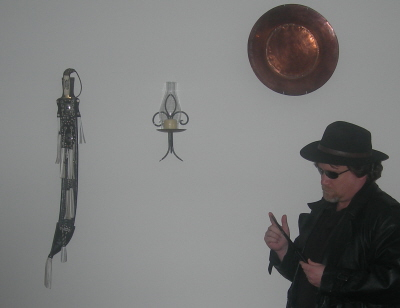|
About This Author
Come closer.
|
Complex Numbers
Complex Numbers
A complex number is expressed in the standard form a + bi, where a and b are real numbers and i is defined by i^2 = -1 (that is, i is the square root of -1). For example, 3 + 2i is a complex number.
The bi term is often referred to as an imaginary number (though this may be misleading, as it is no more "imaginary" than the symbolic abstractions we know as the "real" numbers). Thus, every complex number has a real part, a, and an imaginary part, bi.
Complex numbers are often represented on a graph known as the "complex plane," where the horizontal axis represents the infinity of real numbers, and the vertical axis represents the infinity of imaginary numbers. Thus, each complex number has a unique representation on the complex plane: some closer to real; others, more imaginary. If a = b, the number is equal parts real and imaginary.
Very simple transformations applied to numbers in the complex plane can lead to fractal structures of enormous intricacy and astonishing beauty.
| |
Not much to say today, but I did want to share this link (sent to me by Elisa the Bunny Stik  , who loves brutalist architecture) because, being trained in civil engineering, I do occasionally have Opinions about architecture. , who loves brutalist architecture) because, being trained in civil engineering, I do occasionally have Opinions about architecture.
Save Our Brutalism 
Five decades since the craze for Brutalism, most of the discussion about these buildings is about tearing them down. But the radical social vision that drove their rise has largely been forgotten.
In 1966 Brazilian architect Paulo Mendes da Rocha, a pioneer of postwar avant-garde architecture, built a figurative middle finger in Sao Paulo’s villa district. His creation: two identical geometric houses made of exposed concrete, showing complete disregard for the stylistic norms of his more establishment neighbors.
1) You gotta love architectural terms, even if you don't like the result. "Postwar avant-garde."
2) Some people don't like bare concrete. Me, I'm all about concrete. (It's not "cement." Quit calling it that. It's quite possibly the worst example of synecdoche in existence.)
Today, alas, there is more talk about tearing down buildings in this style than building new ones. But this also reflects a change in the idea of what architecture is for. Far from today’s neoliberal orthodoxy, many Brutalist buildings expressed a progressive or even utopian vision of communal living and public ownership.
Aesthetics aside, I'd think the people into "communal living" are all named Safflower or Prunejuice, and they live in a place without concrete and eat exclusively vegan food that they grow themselves. So they wouldn't be into the whole "box of rock" look.
Today, the battle to protect them is also a fight to defend this social inheritance.
Thing is, architecture, like any art, shouldn't need too much explanation. I'd never have guessed that it was all about "communal living and public ownership" if this article right here hadn't told me. I thought it was pretty much the opposite: a way to dominate the landscape and to spite NIMBYs who insist on having a say in what their neighbors look like.
The name refers not to the adjective brutal, but the French brut, meaning raw.
I'm just including this bit here in case you can't be arsed to read the article (which is fine, but I think it's important to know where words come from).
The root of the term was borrowed from art (Art brut) and from Le Corbusier’s term béton brut (bare concrete). The origin story tells us that during the construction of his Unité d’Habitation social housing complex in Marseilles (1947–52), Le Corbusier was faced with so many overburdened construction companies that out of necessity he decided to leave the huge concrete pillars roughly exposed in bare concrete. He called this method béton brut, and it would be a decisive breakthrough for the formal language of architecture into the 1960s and 1970s. From Corbusier, Banham, and the Smithsons, there thus emerged the building blocks of a Brutalist theory and aesthetics.
One generally associates the French with elegance and subtlety in all types of art, including architecture. Picture la tour Eiffel or Notre-Dame de Paris. Again, I'd never have guessed this polar opposite of elegance and subtlety was a French thing unless it was shoved in my face.
For instance, the telecommunications center in Skopje, Macedonia, looks like an archaic vision of a space station; it openly puts on display its service core, staircases, and concrete support structures. The building’s materials and inner workings were not only exposed, but exaggerated and celebrated.
As an engineer, I tend to value function above form. Not that I don't appreciate a nice form, mind you, but I want to know what something actually is. This, therefore, appeals to me.
The article continues with more history of Brutalism; as I noted above, I don't have much else to say about it, but it's a fascinating read if you're into this sort of thing.
There were also failures that were rightly criticized: overly sophisticated floor plans that tested one’s sense of direction; absurdly segmented flat roof systems susceptible to leakage; inadequate steel reinforcement that caused difficult-to-repair damage to the concrete...
There's an old joke. Well, not really a joke, but a one-liner: Architecture students have to give up many things that other college students take for granted, like weekends, parties, and structural engineering.
The architecture of our parents’ age is slowly becoming the architecture of a generation of grandparents. But with distance comes the possibility of a new, less biased view. In many places, historical preservation has also begun to concern buildings dating to the 1970s. This work is being encouraged and supported by an ever-increasing number of initiatives.
It's been a while, but I've mentioned the life cycle of things in here before. 1) It's new and people ooh and ahh over it; 2) It becomes ordinary; 3) People start to hate it because they want something new, so a lot of it gets discarded; 4) Someone starts liking it again, it's rare now, and there's a mad scramble to preserve whatever's left. This applies not just to buildings, but to pretty much anything. Apparently, Brutalism followed that life cycle.
In the heyday of Brutalism, the architecture of previous generations was widely demolished without much thought. In many German cities, the turn of the century architecture was stripped of its decor or outright demolished at a shocking rate. This inevitably raises the question of whether in fifty years’ time our children and grandchildren will shake their heads and wonder how we could possibly have made the decisions being made right now.
I've mentioned something like this before too. Laugh all you want at the fashion choices of the 1970s; just know that in the 2070s they'll be laughing at our fashion choices just as heartily. That is, if anyone's still around to laugh.
As I've already said more than I intended, I'll leave it at that. The article's there if you're interested. |
© Copyright 2025 Robert Waltz (UN: cathartes02 at Writing.Com). All rights reserved.
Robert Waltz has granted InkSpot.Com, its affiliates and its syndicates non-exclusive rights to display this work.
|

